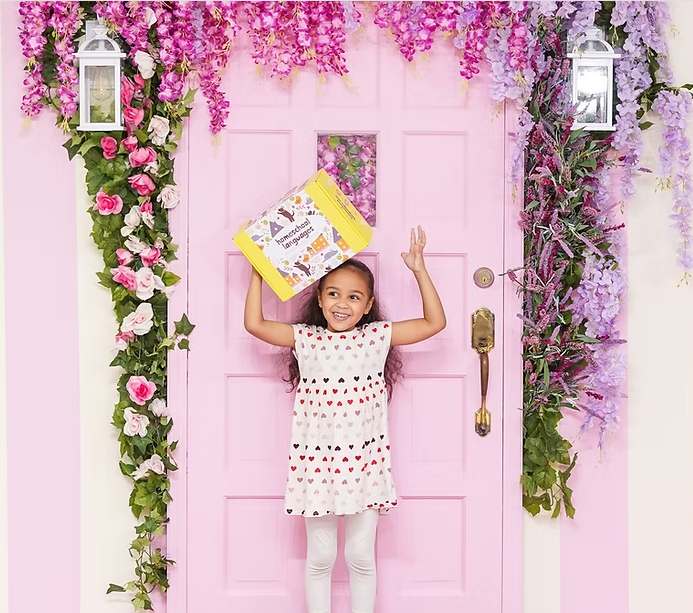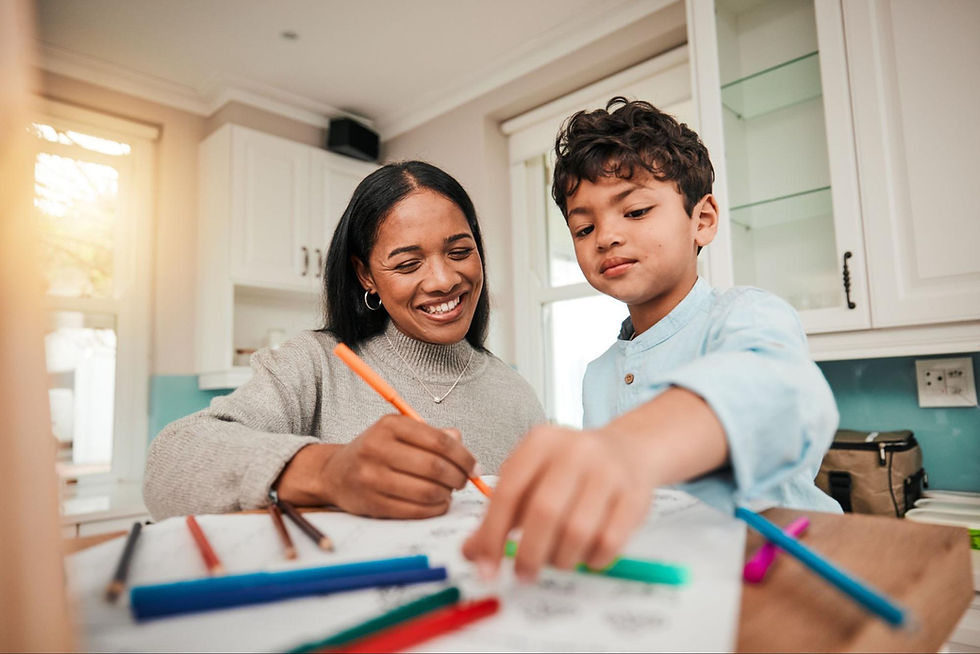Learning New Language As a Child | Timeline, Process, & Tips!
- Homeschool Languages

- Jun 15
- 7 min read
Wondering how long it takes a child to learn a new language? With daily exposure and playful conversation, toddlers and preschoolers can start speaking in just a few months! Here’s what really works, and how you can make it joyful at home.
If you’ve ever asked yourself, “How long does it take for a child to learn a new language?”, you’re not alone. The short answer? It depends.
A toddler can start using common phrases in just a few weeks with daily exposure, while more advanced, academic fluency often takes several years.
And guess what? That’s completely okay. Every child’s journey is beautifully unique.
Whether you’re teaching a second language by choice (maybe you’re dreaming of that bilingual home life) or necessity (new country, new school, new everything), this guide was written for you.
We’ll talk timelines, motivation hacks, and ways to stay consistent without being perfect.
Ready? Let’s start with discovering what fluency actually means before we start chasing it for your child. Let’s go!
Understanding What Fluency Looks Like for Young Children

Let’s start with the two kinds of fluency kids develop, and why both matter.
1. Two Types of Fluency: BICS vs. CALP
When people ask me how long it takes a child to become fluent, my first question back is: Which kind of fluency do you mean?
The first kind is conversational fluency, or BICS (Basic Interpersonal Communicative Skills). This is playground talk, phrases like “I want that” or “No, me!” It’s intuitive and usually shows up early with daily use.
The second kind is academic fluency, or CALP (Cognitive Academic Language Proficiency). This includes explaining ideas, understanding cause and effect, or following multi-step instructions. CALP takes longer, typically five to seven years, even in immersive settings.
2. How Fluency Develops Between Ages 2–7

I’ve learned not to judge fluency by sentence length. A child may be using words confidently but still sorting out grammar or meaning, and that’s perfectly normal.
At this age, true fluency shows up as:
Responding to simple, everyday questions
Using familiar phrases in the right context
Making spontaneous requests without help
It may feel simple, but these small wins are the foundation for long-term success.
Now that we know what fluency actually looks like, let’s look at how long it usually takes to reach that point, and what can make the process faster, smoother, and a whole lot more fun.
Helpful Resource → Can I Teach My Kid A Language If I Don't Speak It
Understanding the Timeline for Children to Learn a New Language
With the right kind of exposure, progress can happen sooner than you might think.
Let’s break it down by how the language is being introduced, so you can set realistic, and encouraging, expectations.
Typical Timelines Based on Type of Exposure
Not all exposure leads to the same results. I’ve watched how the type of language interaction, whether passive, guided, or immersive, makes all the difference in how quickly kids begin to speak.
1. Passive Exposure (Tv, Songs, Background Audio):
If your child is only hearing the language, without any interaction, speech can take years to develop. You might hear a song repeated or a few words echoed, but true language use rarely happens this way.
2. One Hour A Day Of Structured, Interactive Exposure:
This is the sweet spot I’ve seen in my own home. With consistent, playful exposure, songs, scripts, conversations, kids often begin using phrases in just 3 to 6 months. They’re not fluent, but they’re communicating. And that’s a huge milestone.
3. Full Immersion (E.G., School Abroad Or Dual-Language Programs):
If your child is surrounded by the language all day, they often become conversationally fluent in 6 to 12 months. More complex, academic language usually takes 5 to 7 years, even in immersion.
So if you're doing structured language play at home, expect your child to begin speaking within that 3–6 month window, without needing to relocate or overhaul your life.
Why Some Kids Understand But Don’t Speak Right Away
Now, let’s talk about something that surprises a lot of parents: the silent period. I’ve been there too, it’s when your child listens, absorbs, even understands... but stays quiet.
This stage is normal and can last a few weeks to several months.
It doesn’t mean they’re stuck, it means their brain is making connections behind the scenes. Just keep the input going: songs, play, conversation. One day, they’ll speak, and it often happens all at once.
But there are key factors that can influence and speed up the learning process.
The Key Factors That Influence Language Learning Speed

If there’s one thing I want every parent to hear, it’s this: your child’s pace is not just a reflection of your effort, it’s also a reflection of their environment.
Over the years, I’ve watched some kids flourish in weeks and others take months to warm up. The difference? These four key factors.
1. Age of Exposure
The earlier a child is exposed to a second language, the easier it is for them to pick up natural pronunciation and rhythm. Ages 0–5 are considered a golden window, when the brain is primed for language learning and kids absorb without overthinking.
But it’s never too late. Children up to age 10 still have a strong capacity to learn and even sound fluent with consistent exposure.
I’ve seen nine-year-olds make faster progress than toddlers, because they were motivated and involved in the process.
2. Frequency and Consistency
Language skills aren’t built in bulk, it’s built in small, repeated interactions.
Ten minutes a day is more effective than two hours on Saturday. Why? Because the brain thrives on consistency.
It’s daily use, asking for a snack, singing a phrase, saying “hello” to a puppet, that makes the language stick. I always say, keep it light, keep it frequent, and don’t worry about perfection.
3. Language Similarity to the Native Tongue
Not all languages are equally easy to learn, especially depending on what your child already speaks. For English speakers, Spanish is generally quicker to grasp than, say, Mandarin or Arabic, which involve different sounds, sentence structure, and writing systems.
That said, I’ve seen kids thrive in “harder” languages when the learning was fun and relatable. Difficulty matters, yes, but interest and enjoyment matter more.
Helpful Resource → Easiest New Language for a Child to Learn
4. Emotional Environment and Parent Involvement
This may be the most underestimated factor of all.
I’ve watched kids soar in second-language learning simply because their parent made it feel fun, normal, and part of everyday life.
When you're confident, even if you're not fluent, they feel safe to try. But when we get anxious, apologetic, or tense, kids sense it, and it slows everything down.
Up next, we’ll look at what to do when your child has to learn a second language, because sometimes the timeline isn’t in your hands, and knowing how to support them in those moments can make all the difference.
Helping Your Child Succeed When Language Learning Isn’t Optional
Sometimes, language learning isn’t a choice, it’s a circumstance.
If you’ve moved abroad or enrolled your child in a school where a different language is spoken, the timeline and experience look a bit different. And while that can feel overwhelming, it’s also something your family can navigate with the right support.
With support, even reluctant learners adapt more quickly than we expect.
How to Support the Transition
Here’s what I’ve found makes the biggest difference:
Tutoring or pull-out help in their native language gives kids space to catch up academically while building confidence.
Protect their self-esteem. Celebrate tiny wins: understanding directions, using one phrase with a peer, making eye contact with the teacher.
Give them language rest at home. Let their home language be a place of comfort, especially early on.
It’ll work, trust me.
Patience and consistency is key though. And you can always incorporate some solid activities to make things fun and accelerate learning.
Fun Learning: 3 Tips to Make It Fun (So Kids Actually Stick With It)
Let’s be real, young kids aren’t looking for flashcards and grammar rules. If it feels like school, they check out.
But if it feels like play? That’s where the magic happens. Fun is the fastest path to fluency for little learners.
1. The Puppet Trick That Got My Son Talking
When I first tried speaking Spanish with my son, he either ignored me or made up nonsense words.
Then I brought in a puppet, one that “didn’t understand English.” Suddenly, Spanish had a purpose. If he wanted to talk to the puppet, he had to speak the language.

And he did. That one shift opened the door.
2. Use Songs, Play, and Storytime, Not Worksheets
Repetition through play works better than drilling vocabulary. I’d sing phrases like “up” and “down” during routines, and soon my kids were using them in real life.
Storytime helped too, especially simple, predictable books where they could join in.
No worksheets. No pressure. Just connection.
3. Gamify Conversations at Home
Kids remember what they use.
That’s why I focused on high-frequency phrases like “I want,” “Where is…?” and “Can I have?” We’d turn snack time into a mini lesson or play simple games like “Guess Who” with language woven in.
It didn’t feel like practice. It felt like play, and that’s why it worked.
Lastly, it all boils down to how parents approach this mission. With the right mindset and practices, your kid will have an asset they’ll cherish and flex for life!
The Parent’s Role in Raising a Bilingual Child
You don’t need to be fluent to help your child learn a new language.
What matters most isn’t how many words you know, it’s how consistently and confidently you show up.
1. How Your Energy Shapes Their Language Experience
Kids mirror what we model. If language time feels stressful or forced, they’ll resist. But when you approach it with playfulness and routine, even just 10 minutes a day, it becomes part of their world.
2. Why You Don’t Have to Speak the Language Fluently
Nope.
Many parents using Homeschool Languages are learning alongside their kids. You can speak in your strongest language while using a guided curriculum to lead the way. You’re not expected to be the teacher, you’re the guide.
3. Feeling Behind Is Normal (But You’re Not)
Worried you started too late?
You didn’t.
Slow, consistent progress works better than big bursts or full immersion. One phrase learned today is better than a perfect plan for someday.
Conclusive Thoughts — Simple Next Steps to Get Started Today
Here’s what I want you to remember: early exposure works, fun keeps kids engaged, and you don’t need to be fluent to guide your child.
Progress comes from small, consistent moments, not perfection.
So what now?
Choose a method that feels doable for your family.
Stick with short, daily interactions, even 10 minutes counts.
Watch for small wins, like a new phrase used at snack time or bedtime.
And if you want a proven, step-by-step way to bring language into your home, without overwhelm, that’s exactly what Homeschool Languages is here for.
From your first “hello” to full back-and-forth chats, we’ll guide you every step of the way.

Try the first lessons free and see just how joyful this journey can be.




Comments